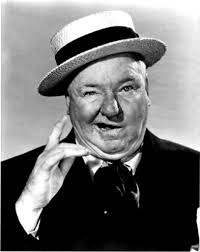
"During one of our trips through Afghanistan, we lost our corkscrew.
We had to live on food and water for several days."
-W.C. Fields
*Coffee, Tea and Other Mission-Critical Essentials*
By: gvi
25 January 2015

"During one of our trips through Afghanistan, we lost our corkscrew.
We had to live on food and water for several days."
-W.C. Fields
Water is critically essential to life, a fact so elementary it needs no further elaboration.
This is not the same thing as saying you actually have to drink the stuff straight. I incline to the belief that drinking plain, unadulterated water when other wholesome and civilized options are available is much the same thing as Thoreau said of sitting on a pumpkin; in his own words,
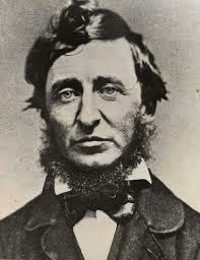
"That is shiftlessness."
Such a declaration must be qualified. Sometimes, only water will do. Camelbaks and canteens, for example, should have nothing besides water in them. This has more to do with keeping said vessels sanitary than it has with the need for hydration when afield. In the field, a Camelbak or canteen filled with sports drink or Kool-Aid becomes a breeding ground for all sorts of nasties much quicker than one filled with only water. Both should be cleaned regularly; but in the field this seldom happens, and old campaigners can recall from memory the funky pong of an unsanitized canteen.
If you must have something "fortifying" out in the big sticks, at least have some class and get a hip flask we're all old enough to have nice things.
If my options aren't limited by necessity, I drink my water "doctored up," and most times this doctoring-up comes in the form of coffee or tea. One advantage to coffee and tea is that unlike pop, dairy products or alcohol, they store easily, keep well and lend themselves readily to "post-SHTF" brewing.
Some of us cannot have coffee or tea or indeed anything caffeinated. Those under such limitations are unlikely to read this essay anyway. The remainder will discuss how I come by my coffee and tea, how I keep it and what I do with it once I'm ready to use it.
Coffee and tea have in common the fact that they are decoctions or infusions of vegetable matter beans in the case of coffee, leaves in the case of tea. What separates them is this: the variation in the tastes of the several types of coffee is largely the result of the method of its preparation; whereas with tea, its variety comes from the style of leaf and the method of processing.
Put another way, if you want to make coffee taste differently, you make it differently if you want to make tea taste differently, you buy a different type of tea.
There are several varieties of coffee, but the chief ones are Arabica and Colombian. There are kinds from the South Sea islands, from Africa and elsewhere (Jamaican Blue Mountain coffee runs $60/lb and is worth every penny), and there's at least one kind whose "processing" requires the beans to be eaten and defecated by civet cats I'm not making this up. They are also roasted differently and they taste different, but the distinction is subtle. In truth, most coffees taste more-or-less the same if they're prepared the same way. On the other hand, espresso is different from Italian coffee, which itself is different from the coffee had of a French Press or a stovetop percolator, a drip coffeemaker or a vending machine, etc.
I'm pretty cheap when it comes to my coffee. I buy it from the Dollar Store or Aldi, and my espresso-ground coffee is Cafι Bustelo which is relatively inexpensive per ounce. Chez GVI boasts no fewer than six different sets of equipment for making coffee, and everyone has at least one the humble saucepan. Yet even "cowboy coffee" can be made well if care is taken in the preparation. All my methods for making coffee lend themselves to "post-SHTF" brewing. There is no electric coffee appliance here I find them unnecessary and wasteful of "juice." You will also note that in every method I use, the only thing thrown away is the coffee grounds or tea leaves I use no filter or bags. I believe in good stewardship and abhor waste, but I'm no eco-warrior; however, if you are, Dear Reader, these methods recommend themselves for this additional salutary reason.
A brief discussion of each method follows:
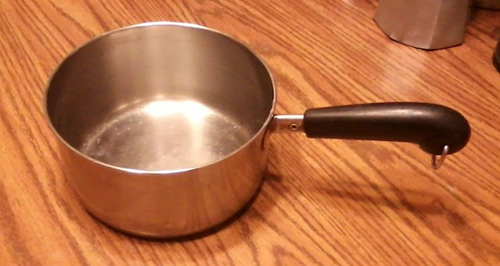
Boiling in a saucepan
The simplest way to make coffee in terms of equipment is in a saucepan. Everybody has one. This can make some of the best coffee you've ever had, but the secret is in the technique. Get a quantity of water boiling and, once it's at a solid rolling boil, remove it from the heat source and immediately dump in the coffee, about a tablespoon more-or-less per large cup. Let it steep for four minutes coffee must never be allowed to brew longer than five. Stir gently to loosen the grounds and swirl them around, and then sprinkle a tiny pinch of salt into the water. The grounds will immediately sink to the bottom.
One of the best cups of coffee I've ever had was made thus. One frosty morning in the field, our Mess Sergeant made up a large vat and left it on a diesel burner to stay warm you dipped your canteen cup into the vat and fixed it up to your liking. More than a few in our Company remarked that the simple act of sharing from a common vessel such as we did led to a greater feeling of camaraderie during that field problem, and it's hard to argue against anything which tends to foster goodwill and fellowship in a group.
It has grounds in the bottom but one need never drink the dregs of any coffee. Maxwell House made a fortune off its slogan "good to the last drop" but only because prior to the ad, nobody ever finished the last drops and hence wouldn't know any better.
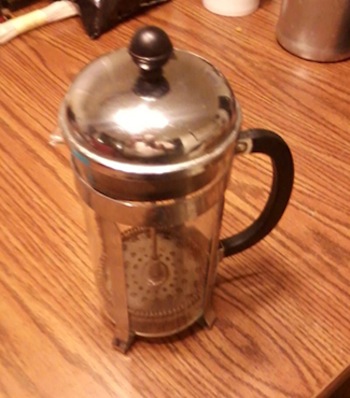
French Press
The French Press is the next up in terms of sophistication. The proportion of coffee to water is about the same a tablespoon for a large cup. It is much like the former method, except the water is boiled separately and the grounds are placed in a cylindrical carafe with a lid featuring a screened plunger. The water, when it boils, is poured into the carafe and the brew is stirred. The lid with the plunger is then fitted in place and the coffee is left to steep. After four minutes, the plunger is pressed, pushing the grounds to the bottom and stopping the brewing process. It is mechanically more complicated than the boiling method above, but functionally simpler because it doesn't take as much care you merely have to follow instructions. The coffee is strong but smooth it's impossible to get that "burnt" taste from coffee that's been left heated too long, though over-steeping will make it bitter.
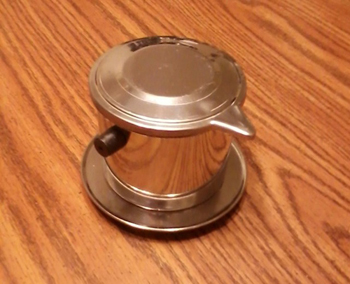
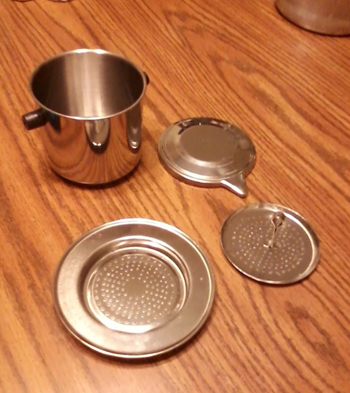
The vessel has little holes in it too
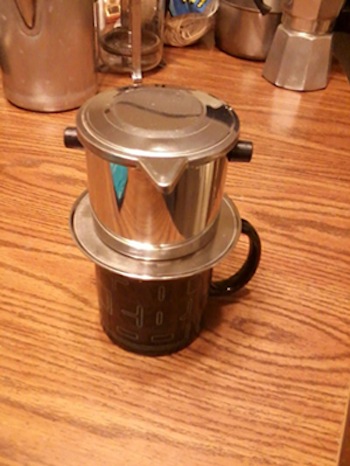
Vietnamese Phin
I recently picked up the contraption the Vietnamese people use for making their "phin" variety of coffee. It is similar to the French Press and while I can't back the claim with documented fact, it stands to reason the Vietnamese got the taste for it from their former colonizers. It is made one cup at a time, and the Vietnamese are said to prefer it with canned condensed sweetened milk. I suspect the reason they prefer it this way is because the canned stuff is easier to come by than fresh milk or cream, and likely safer besides. Like anything related to coffee, aficionados can be quite particular about how it's done, even which coffee brand to use and which brand of condensed milk. I just use regular coffee (not espresso grind) and whatever brand of condensed milk I happen to have handy. Or milk and sugar because I'm not that much of a coffee snob. It's really just another way to make a good cup of coffee.
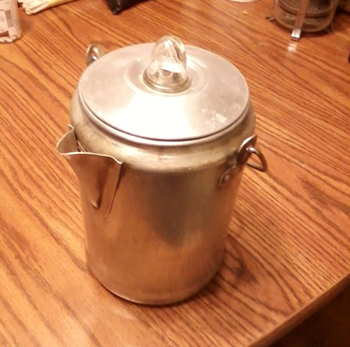
Stovetop Percolator
All percolators stovetop and electric - work on the principle of forcing boiling water up a spout and washing over a basket of coffee suspended above it. Electric percolators stop the brewing process with a thermostat, but stovetop models require you to know when to shut off the gas or take the pot off the heat source. Some judgment is required, because your coffee can easily become bitter or get a "burnt" smell and taste if left too long. My best results have come from removing from heat about two to two-and-a-half minutes after the coffee has started to perk. It will continue to perk for a minute or two afterward but will not be bitter or burnt.
I've owned glass percolators before but they were antiques which have since cracked and been destroyed. For our purposes metal is the only way to go.
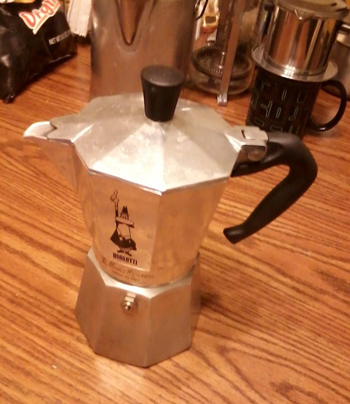
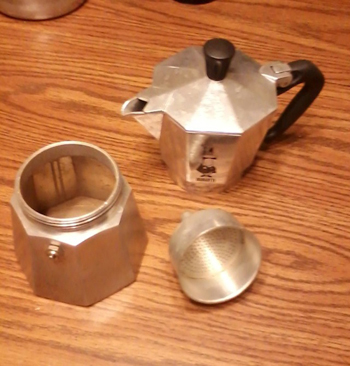
Moka Pot
The Italians are credited with inventing espresso; along with food, wine, high-performance motorcycles and fascism, coffee of all kinds is something the Italians do very well. The Moka Pot was invented by the Italian firm Bialetti in the 1930s and remains essentially unchanged. It doesn't quite make espresso but something very close. It uses the same fine grind and works on an interesting principle similar to percolation but different, in that the water is only run through once. The Moka Pot has two vessels. The lower one holds water and a sort of funnel with a filtered basket for the espresso-ground coffee. The upper pot has a second filter at the bottom (to keep the grounds where they belong) and a fountain spout running up its center.
When the water in the lower vessel is heated, the water of course boils, creating steam. Steam will expand where water itself is incompressible; therefore, the steam will push the water up the funnel and through the grounds, past the second filter, up the fountain spout and into the pot above. It is removed from heat once it starts steaming and gurgling and served immediately. This type of coffee is strong and thick and has a sort of liqueur consistency which lends itself nicely to being savored in small amounts. If you ask for a regular coffee in Italy, this is what you're liable to end up with, and you could do far worse. One reviewer of the Moka Pot says of it, "It makes coffee that tastes like it smells." It is relatively easy to clean, as you end up with a sort of tablet of coffee grounds which pops out of the filter basket looking a bit like a hockey puck.
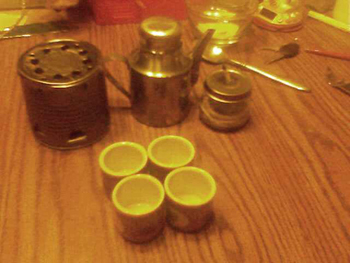
The cheap ibrik I own
(Made from a creamer bought in Chinatown)
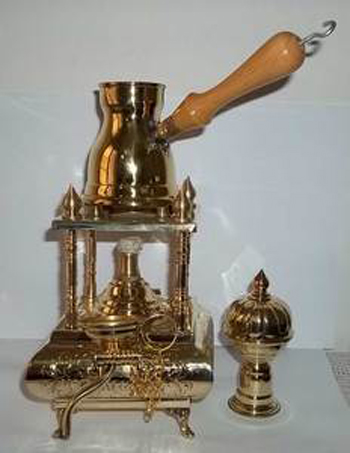
The fancy ibrik I want
(Photo from vendor)
Ibrik
Turkish coffee is made in a tiny pot called an Ibrik, which is in fact a Greek name the Turkish name is spelled cezve and I haven't the faintest idea how it's pronounced. The grounds are finer even than espresso and the coffee is simply placed on top of the water. There appear to be two schools of thought as to how it's supposed to be made. One holds that the water must never be brought to boiling but that it be stirred once it starts foaming, and the other calls for letting the coffee boil two or three times, removing it from heat in between.
If American coffee is made for drinking and Italian coffee is made for sipping, Turkish coffee is made for simply tasting. It's the strongest stuff you can buy without a prescription, and it's served in cups about the size of a shot glass. It is not drunk so much as savored you take in about as much per tiny sip as you normally would when drinking communion wine. You don't want to take more; two regular cups of this stuff and you can pick up radio transmissions from airplanes on the final approach to your nearest airport via the fillings in your teeth. It is traditionally served with dessert or taken while sitting around smoking a hookah. It is considered a communal drink in its native country, not something one makes only for oneself.
There are other ways to make coffee of course a sampling of Starbucks' menu shows the many thousands of combinations you can get. But the six above are sufficient for me both now and after The Big One. More to the point, so long as I have water, coffee and fire, all will be available to me both now and after The Big One.
People who wouldn't get defensive if you accused them of "coffee snobbishness" generally say the best coffee is freshly roasted and freshly ground. There is merit to the claim. But in the context of preparedness, some compromises must be made between The-Ultimate-Coffee-Experience and What-Works-Best. For example, a Chemex coffeemaker is said to brew an amazingly good cup. On the other hand, I wouldn't care to try and put a glass Chemex in my Fast Pack , whereas a phin or a Moka pot would ride along quite well. Likewise, the energy either electric or muscle necessary to grind whole beans (to say nothing of roasting them) can be put to better use elsewhere.
In a true long-term catastrophe coffee will naturally be hard to come by the Confederacy during the Civil War and most of Europe during the World Wars bear witness to this. Coffee's not the cheapest thing in the world but its expense is a light enough burden to make it worth putting several pounds up. Left sealed in its original packaging it will keep for at least a year and often longer. The Italian espresso brand "Illy" puts its coffee in cans that appear to have been designed to meet some sort of military specification.
I purchase my coffee in smaller quantities. It's just me and my daughter here at Chez GVI after all, and we don't go through vast amounts. Smaller packages allow more flexibility than large cans, though the price-per-ounce tends to be greater. Vacuum packs are ideal for me in terms of space used for storage and keeping their freshness for a long time.
We keep a trifling quantity of instant coffee, of which little can be said except the obvious fact that there's not much you can do with it other than get it hot and be thankful to at least have something civilized to drink. Perspective and gratitude count for much with instant coffee. When you're out in the field cold, wet, saturated in fatigue and misery a cup of "instant" is as welcome as the rancid water given to the narrator of "Gunga Din" when he was in his extremity. Starbucks' "VIA" comes about as close to resembling real coffee as any I've tried so far; but while it's convenient, it's still instant.
As I said before, the difference in teas doesn't come from the means of preparation. The English and Japanese have very definite opinions on the right way to make tea George Orwell wrote an essay (full link http://www.booksatoz.com/witsend/tea/orwell.htm) on the proper way to make tea fit for English drinkers. Their opinions notwithstanding, all are brewed more-or-less the same the difference in taste comes from the variety of tea you make it with.
Anyone with a saucepan and a heat source can make tea. This simplicity is part of its global appeal. The best method for brewing it is to get the water boiling and then pour it over the tea leaves. Tea snobs think different varieties of tea call for different temperatures of water but everyone seems to agree that the water should be got to boiling first. I incline toward this consensus. tea from water which hasn't reached boiling tastes different (and worse) than tea from water which has been boiled.
The leaves themselves should never be stewed in a pot or put in a microwave. You end up with a bitter, unhappy broth good for nothing besides dyeing canvas or muslin khaki.
Through time and experience I've come to discover that the cheapest way to get tea is in bulk and not in tea bags. Bulk tea has the added benefit of tasting better than tea bags. Besides, if you've ever opened a tea bag and compared its contents to bulk tea leaves, the former look more like they belong in a dustpan than in your cup. Many things in life don't bear up to strict scrutiny, and tea bags are an excellent example.
Amazon.com makes it easy to buy tea in bulk a quick search reveals several vendors who sell tea very cheaply by the pound or kilogram a kilogram of tea will last a LONG time. I also have the advantage of being near Chicago's Chinatown neighborhood, and can get many types of teas relatively cheaply. If you have an oriental market near you, pay them a visit it's where the "good stuff" is kept.
I store the kilogram bags in the freezer and keep the amount I'm going through in containers with tight-fitting lids. Tea demands little in terms of storage. The only important factor and it IS important is that the container it's stored in must be absolutely dry, otherwise the tea will ferment.
Bulk tea produces less waste than tea bags this is not merely a benefit for the environmentally-conscious, but preparedness-minded reader will surely see the benefit of having LESS trash if trash collection services cease. Tea, like coffee, can simply be composted.
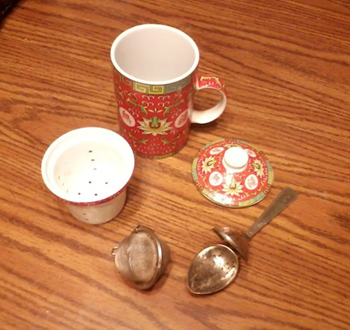
There are different ways to hold tea leaves in suspension. There are baskets for teapots, wire-mesh balls, little curiously-shaped infusers and so forth. Orwell didn't think any such containment was necessary; but while I can live with a few small leaves at the bottom of my cup, too many is just a nuisance. Certain types of green teas are traditionally brewed with the whole leaves floating around in the cup and slurped around. Formerly, tea used to be sold in compressed bricks you can still find these bricks from various vendors with the appropriate amount being scraped off into the water. I confess to never having made tea this way (though I have a couple bricks, used for decoration), so I can't render an authoritative judgment on it.
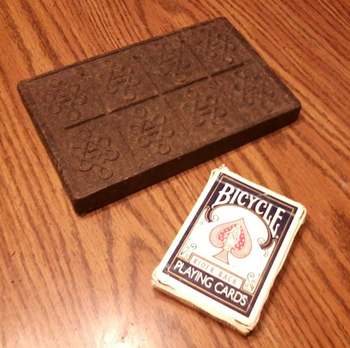
A tea brick (cards shown for scale)
The tea floating in Boston Harbor during the "Tea Party" looked like this
Like coffee, four minutes is the right time for steeping, and for the same reasons.
There are many subtle differences in making tea the Japanese have whole rituals devoted to it but the end result is largely the same and if it's a good cup of tea you're after, it doesn't really matter what ceremony you use, if any. One exception to this is the traditional Russian method of making tea, which is made extremely strong and then diluted to taste. It's a method which, when done right, results in a pretty good "cuppa," but I lack the patience and knack for it.
I should spare a word or two about iced tea. Being a damnyankee, I grew up with unsweetened iced tea, though I prefer it the way it's made in the south. Sun tea is popular but since I don't use tea bags, I have a different method, similar to Russian hot tea. I put a cup of sugar and about a quarter-cup of leaves in a teapot, brewing a sweetened and very strong concentrate which I then pour into a half-gallon pitcher filled with ice cubes, adding water to bring it to a full half-gallon. It makes a very full-flavored iced tea which is ready instantly.
Another recommendation in the line of economy is the poorly-known fact that tea can be reused. It can't be left aside forever, but the tea you drank last night as a soothing nightcap can be safely steeped for breakfast. Just leave it in whatever you had it in strainer or teapot and use it at least twice. How many decent cups you can get out of your tea is dependent largely upon its variety. Black teas can be reused maybe three times, though the third will be weaker. Green teas, however, can be reused four or five times.
I've never had a good second cup from bagged tea.
A few years ago my daughter brought my attention to the following wholesome Andy Warhol quote:
"What's great about this country is that America started the tradition where the richest consumers buy essentially the same things as the poorest. You can be watching TV and see Coca Cola, and you know that the President drinks Coca Cola, Liz Taylor drinks Coca Cola, and just think, you can drink Coca Cola, too. A coke is a coke and no amount of money can get you a better coke than the one the bum on the corner is drinking. All the cokes are the same and all the cokes are good. Liz Taylor knows it, the President knows it, the bum knows it, and you know it."
It's true, but on the other hand, coffee and tea have the advantage that the poorest of us can even in a post-SHTF world have a cup which is every bit as good as that served to Liz Taylor and the President.
It's all in how you go about making them.
The title of this essay is "Coffee, Tea and Other Mission-Critical Essentials." I would be doing the reader a disservice if I didn't include one other VERY inexpensive yet VERY welcome "Mission-Critical Essential" in the line of drinking something besides water. That would be the recipe for my homemade sports drink.
Sports drinks whether it be Gatorade, Powerade or any other ade are not much more than Kool-aid, high-fructose corn syrup and a few minerals. At their cheapest, they cost about a dollar a quart. Now suppose I told you that I make mine for about 18’ a quart. Here's my recipe:
For 2 quarts:
Mix these all in a half-gallon pitcher and fill with cold water.
It has all the stuff you buy sports drink for, and if you get your ingredients on sale, you can make it for under 20’ a quart just like I do. It tastes close enough to commercial sports drink to make it worth the effort. But lastly, it has the added benefit that besides the instant powder, you can pronounce all the ingredients in it!
gvi
www.alpharubicon.com
All materials at this site not otherwise credited are Copyright © 1996 - 2015 Trip Williams. All rights reserved. May be reproduced for personal use only. Use of any material contained herein is subject to stated terms or written permission.